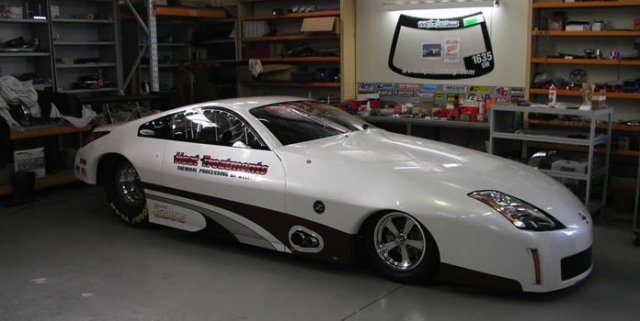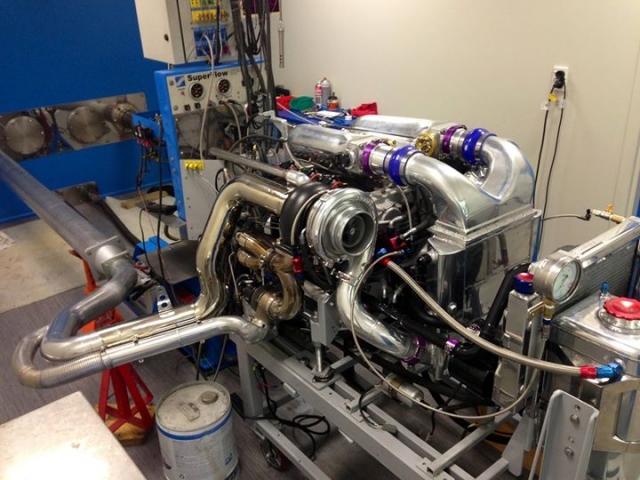Building a 3.5-liter V6 engine destined for Pro Mod activity is a task not for the faint-of-heart, but the McGregor family of Auckland, New Zealand, is up to the challenge. Working with noted MoTec tuner Shane Tecklenburg over the last few years, the team is putting the final touches on the engine’s development on the dynamometer. EngineLabs caught up with Tecklenburg to discuss the engine’s potential, what it takes to make nearly one ton of horsepower, and other aspects of the engine’s performance.
The VQ35 engine was designed and built by Keith McGregor out of the family’s Heat Treatments Ltd. facility and is still in the development cycle. As there have been other VQ35 engines built to make the same type of power, but have encountered longevity issues, the team is taking it slow, and to that end enlisted Tecklenburg to assist in the development process.
“We have no indication from the plugs or the data or the oil filter that there is any problem. They were going to be satisfied with 1,500 horsepower and I pushed them to 1,800. We all agreed to stop there. We have the impression that it is better to stop now and find a problem coming than keep at it for ego sake and try to pick through the rubble afterward to find what may have gone awry,” says Tecklenburg.
No expense was spared in creating this engine - it's a project five years in tthe making, and the Heat Treatments Ltd. team is hoping to have it out in Pro Mod competition later this year.
The engine uses a factory Nismo (Nissan Performance) crankshaft, factory cylinder heads and block that has been sleeved with steel liners to add more strength – necessary when the consideration of 35-plus pounds of boost is taken into account. Also housed in the block are a set of aluminum connecting rods and forged JE pistons designed to handle the massive boost levels. Oil is controlled by a dry sump oiling system from Peterson Fluid Systems. The cylinder heads rely on Ferrea valve springs, Ferrea titanium intake and Inconel exhaust valves. Web camshafts actuate the valves, and Heat Treatments Ltd. designed the custom billet intake manifolds. An Aeromotive mechanical fuel pump and regulator push the M1 fuel through 12 Injector Dynamics ID2000 fuel injectors provide the necessary volume; the fire is lit by Mercury Marine CDI coils and NGK Iridium spark plugs. Boost comes from a pair of Precision Turbo 82/85 turbochargers using the company’s high-efficiency CEA compressor wheels, and twin TiAL 60mm wastegates keep the boost levels in check.
In the video above, one of the flexpipes popped off the wastegate and the engine still pumped out 1,804 horsepower and 1,044 foot-pounds of torque – an astonishing number for such a small-displacement engine – and they’re not done yet as there is plenty of overhead left in the turbochargers to achieve more if the engine platform will support it.
Tecklenburg has proven to be the master of MoTec tuning, with customers all over the world in many different forms of racing. Using his experience, he recommended the McGregors use the MoTec M800 Engine Management System and MoTec CDI-8 eight-channel capacitive discharge ignition system to ensure the engine would perform as required under power.

The Pro Mod Nissan 350Z to be driven by Reece McGregor relies on the engine detailed here along with an air-shifted Liberty 5-speed transmission, 4-link suspension, and all of the attendant gear expected of a car that will touch low six-second elapsed times.
Tecklenburg explains that it’s not all his doing, though. “They listened to my recommendations to use Injector Dynamics Injectors and of course the MoTeC. They are the ones who engineered the power. Contrary to popular belief – tuners don’t “make” power. The power comes from the engineering of the parts and the amount of air the engine will move. If I do my job correctly it makes the power level they designed into it. Anything less than that is either a countermeasure to keep the engine alive or a lack of talent on the part of the tuner/calibration engineer.”
He continues, “When these guys are more comfortable with the hard parts in the engine – we will have a “which is stronger” contest between the engine and turbos and then it will do something really exciting.”
We’ll be watching for that video, Shane.




















